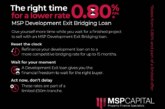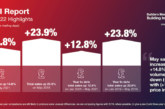
Nail down your exit strategy to boost your chance of securing competitive funding, says Samantha Williamson, bridging & development specialist at Roma Finance.
What happens at the end of a bridging loan is one of the most important parts of the whole process. Both the borrower and lender need a clear understanding of the exit strategy from the off. Not only will it mean you’re better prepared to plan and deliver your property project, it also boosts your chance of securing funding swiftly.
How to exit
There’s no best way to redeem your short-term property finance – it depends entirely on your particular project and future plans.
Your exit strategy could be selling the property, renting it out and remortgaging onto a long-term buy-to-let mortgage, or moving onto a longer-term loan with the same lender using a bridge-to-term product.
Having a clear goal and a plan to get there is what’s essential.
What lenders want
The best bridging and development finance lenders have one goal in mind – helping you create wealth through property. That’s why developers should be careful about partnering with funders that aren’t asking questions about your exit strategy from the off.
When a lender insists on a clear exit plan, it’s because they want your property project to succeed, for you and them.
They’ll start by checking your schedule of works and costings to make sure they’re realistic. At the moment you can expect to be asked to include a generous contingency of at least 10%, given rising prices.
And they’ll want to know how you plan to repay the loan. Having all of this ready before you apply for bridging finance will boost your chance of success.
Where a customer doesn’t have a robust exit plan in place, they risk being forced to move onto another short-term property loan, with associated fees. And that can be really costly. Of course, there are inevitable bumps in the road with development projects and you can’t account for them all.
But short-term finance becomes prohibitively expensive when it’s needed for longer than expected. That’s why lenders and borrowers need to work together to nail down their timescales and exit strategy.
Quicker decision-making
The good news is that this extra scrutiny shouldn’t mean it takes longer to secure bridging funding. In fact, it’s often quicker.
If your project makes sense and the lender can see that your exit is realistic, you’ll get a bridging loan offer without delay or requests for further information.
Ongoing support
The focus on exit strategy doesn’t (and shouldn’t) stop when you drawdown your funds.
The best lenders are proactive about checking progress throughout the loan term. They want to ensure things are on track, help where they can, share expertise and offer amendments or extensions if needed.
Consider it a red flag if a bridging lender isn’t focused on your exit strategy. Your funding partner should be thorough when assessing your property project, for their sake as well as yours.








